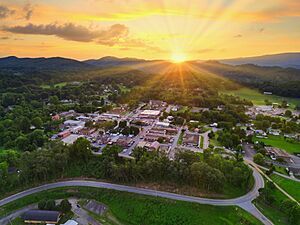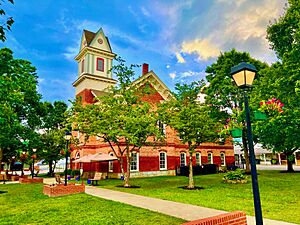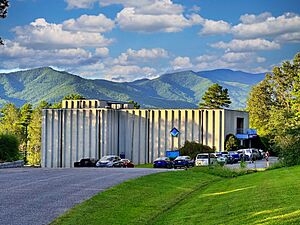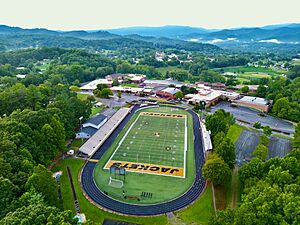Hayesville, North Carolina facts for kids
Quick facts for kids
Hayesville, North Carolina
|
|
|---|---|

Downtown Hayesville
|
|

Location of Hayesville, North Carolina
|
|
| Country | United States |
| State | North Carolina |
| County | Clay |
| Area | |
| • Total | 0.64 sq mi (1.65 km2) |
| • Land | 0.64 sq mi (1.65 km2) |
| • Water | 0.00 sq mi (0.00 km2) |
| Elevation | 1,890 ft (580 m) |
| Population
(2020)
|
|
| • Total | 461 |
| • Density | 724.84/sq mi (279.84/km2) |
| Time zone | UTC-5 (Eastern (EST)) |
| • Summer (DST) | UTC-4 (EDT) |
| ZIP code |
28904
|
| Area code(s) | 828 |
| FIPS code | 37-30280 |
| GNIS feature ID | 2405807 |
Hayesville is a small town in Clay County, North Carolina, United States. It is the main town and the county seat of Clay County. In 2020, about 461 people lived there.
Contents
History of Hayesville: A Journey Through Time
Hayesville has a long and interesting history. It was once a very important place for Native American tribes. Later, it became a town for settlers and grew over time.
Quanassee: An Ancient Native American Village
Long ago, this area was home to Native American people. Around 1000 CE, people from the South Appalachian Mississippian culture built a large earth mound here. This mound was likely the center of their village.
Later, the Cherokee people built a town called Quanassee on this very spot. They used the mound for their townhouse, a place for important meetings. Quanassee was one of many "Valley Towns" along the Hiwassee River in Western North Carolina. It was also on a major trade route called the "Trading Path". This path connected Quanassee to other towns, like Murphy, North Carolina and Great Tellico in Tennessee.
By 1550, Quanassee had hundreds of people living there. In 1716, officials from South Carolina met with Cherokee leaders in Quanassee. They wanted the Cherokee to join them in the Yamasee War. The next year, South Carolina built a trading post there. They traded English goods for things like deerskins from the Cherokee.
In 1725, a group from the Coosa (Creek) tribe attacked Quanassee. They destroyed the village, and many people were captured or killed. The town was briefly rebuilt before the American Revolution. In 1776, soldiers from the Rutherford Light Horse expedition camped there. In the 1820s, Baptist missionaries visited Quanassee to preach to the families living there.
Fort Hembree and New Settlers
In October 1837, soldiers from Tennessee built Fort Hembree near Hayesville. This fort was used to hold about 1,000 Cherokee people. They were then forced to leave their homes and move far away. The military left Fort Hembree in June 1838. However, it was used again in 1860 to train soldiers for the Civil War.
After the Cherokee people were forced to give up their land, European settlers moved into the area. They began farming on what is now called the Spikebuck Town Mound and Village Site. This farming disturbed the top layers of the ancient village. Archeologists studied the site in the 1960s and 1970s. In 1982, the mound and village site was added to the National Register of Historic Places. This means it is a special historical place.
Clay County bought the mound site in 2000 to protect it. In 2011, a group called the Archeological Conservancy bought the village site and old farm areas.
How Hayesville Was Founded
Hayesville was named after a politician named George Hayes. In 1860, he learned that people in the southeast part of Cherokee County wanted their own county. It was hard for them to travel to the distant county seat. Hayes promised to help them get a new county if he won the election. He won!
In February 1861, a law was passed to create a new county. It was named Clay County after Henry Clay, a famous statesman. The county seat was named Hayesville, after George Hayes. Hayesville became an active town in 1861, and its borders were set in 1882. But it wasn't officially a town until March 12, 1913. The first mayor was S.E. Hogsed.
Hayesville High School started in 1870 as Hicksville Academy. In the 1890s, Duke University bought it and offered college classes. The first courthouse in Hayesville burned down in 1870. The brick courthouse you see today was built in 1888. It is also on the National Register of Historic Places. In 2007, the courthouse moved to a new building about 1 mile (1.6 km) west of downtown.
Hayesville's Methodist and Presbyterian churches are the oldest in Clay County. Both started in 1838. Their current buildings opened in 1943 and 1960. Truett Memorial, the town's first Baptist church, began in 1850. Its stone building opened in 1949.
Hayesville's post office opened on May 7, 1868. The county's first official bank opened in Hayesville on May 18, 1910. In October 1920, a railroad line called the Peavine came to Hayesville. It connected to the Southern Railway in Andrews, North Carolina. This line mostly carried lumber and was taken apart in 1951.
Tiger’s Store downtown is thought to be the oldest business in Clay County that has always been open. It started around 1899 and moved to Hayesville around 1908. Hotels began to appear in Hayesville in the 1920s. Clay County had a silent film theater in the 1920s. Later, the Hayesville Theater showed movies and had live music from the 1940s to the 1960s. Famous musicians like Lester Flatt, Earl Scruggs, Minnie Pearl, and Hank Williams performed at Hayesville High School in the 1940s and 50s. In 1945, Paul Westmoreland first played his song “Detour (There's a Muddy Road Ahead)" in Hayesville. He wrote the song while traveling to Murphy. Today, there are no movie theaters in Clay County.
On January 22, 1922, a big fire destroyed almost all of downtown Hayesville. Many stores, the highway office, and the U.S. Post Office were lost. The fire started at DeWease’s Hardware Store and was reportedly set on purpose. The town’s current post office building was built in 1965.
Hayesville Today: Culture and Growth
Clay County is working to show off its Cherokee heritage. This helps make the area special. Besides the Spikebuck Town Mound, Hayesville has other Cherokee sites. The Quanassee Path is a walking trail around Hayesville that highlights five Cherokee features. The Cherokee Homestead Exhibit shows rebuilt traditional summer and winter houses and a corn crib. There is also the Cherokee Botanical Sanctuary. The CCCRA also holds an annual Cherokee Heritage Festival.
Clay County's public library started in a small room in Hayesville. In 1940, it joined the Nantahala Regional Library system. A new library building opened in 1967. It was named Moss Memorial Library after Dr. Fred A. Moss, who helped pay for it and donated books. Today, Moss Memorial Library is the only public library in Clay County.
In the early 1940s, the Tennessee Valley Authority built Chatuge Dam near Hayesville. This created Chatuge Lake. It was the tallest earthen dam in the world until the Aswan Dam was built in Egypt in 1964. In 2017, the dam was added to the National Register of Historic Places.
Hayesville's yearly Festival on the Square began in 1980. The town's yearly Christmas parade started in 1987. Even though it's a small town, Hayesville got the only community theater in far-west North Carolina in the 1980s. The Peacock Playhouse was built by Lillith Lidseen. She was born in Sweden in 1904 and studied art. She moved to the area after her brother started a business nearby.
A volunteer group called the Licklog Players started performing shows in 1978. Lillith Lidseen was asked to direct one of their plays. Because people loved the shows so much, she decided the area needed a professional theater. She built a three-story playhouse with 250 seats near downtown. Construction began in 1983. The first show there was The Curious Savage on June 6, 1986. Lillith Lidseen passed away in 1987.
In 2007, the Lilith Lidseen Performing Arts Association was formed. They raised money to buy and fix up the building in 2009. The Licklog Players performed over 100 plays there before moving and closing in 2014. Today, the Peacock Performing Arts Center hosts many events each year, from comedies to concerts.
In 2003, the US 64 bypass through Hayesville was made into a four-lane highway. NC 69 from Hayesville to Georgia was also widened to four lanes in 2024. The Clay County Recreation Center was built in Hayesville in 2007 and made bigger in 2013. In 2017, Reader's Digest magazine called Hayesville one of the top ten nicest places in America!
Who Has Been Mayor of Hayesville?
Hayesville has had many mayors since it became an official town. Here are some of them:
- S.E. Hogsed (1913)
- Paul "Bud" Vaught, Jr. (1973-1998)
- Gwen Weaver (1999-2003)
- Harrell Moore (2004-2012)
- Harry Baughn (2013–2021)
- Joe Slaton (2021–present)
Education: Schools in Hayesville
The public schools in Hayesville are run by Clay County Schools. All four schools are on one central campus in Hayesville:
- Hayesville High School
- Hayesville Middle School
- Hayesville Elementary School
- Hayesville Primary School
About 1,200 students attend these schools.
For higher education, there are colleges nearby like Tri-County Community College, Young Harris College, and Western Carolina University.
The John C. Campbell Folk School is also nearby in Brasstown. It is the oldest and largest folk school in the United States. This school teaches creative folk arts to people of all ages. It also offers community dance and concert entertainment.
Geography and Climate
Hayesville is a small town with a total area of about 0.4 square miles (1.0 km²). All of this area is land. The Hiwassee River flows around the edges of Hayesville.
Hayesville has a humid subtropical climate. This means it has cool winters and hot summers.
| Climate data for Hayesville, North Carolina(1991-2020 normals) | |||||||||||||
|---|---|---|---|---|---|---|---|---|---|---|---|---|---|
| Month | Jan | Feb | Mar | Apr | May | Jun | Jul | Aug | Sep | Oct | Nov | Dec | Year |
| Mean daily maximum °F (°C) | 49.0 (9.4) |
54.0 (12.2) |
60.1 (15.6) |
69.1 (20.6) |
75.4 (24.1) |
81.2 (27.3) |
84.3 (29.1) |
83.5 (28.6) |
79.1 (26.2) |
70.4 (21.3) |
60.1 (15.6) |
52.1 (11.2) |
68.2 (20.1) |
| Daily mean °F (°C) | 36.7 (2.6) |
40.4 (4.7) |
46.7 (8.2) |
54.3 (12.4) |
63.0 (17.2) |
69.9 (21.1) |
73.3 (22.9) |
72.3 (22.4) |
66.9 (19.4) |
56.5 (13.6) |
46.3 (7.9) |
39.9 (4.4) |
55.5 (13.1) |
| Mean daily minimum °F (°C) | 24.4 (−4.2) |
26.7 (−2.9) |
33.3 (0.7) |
39.5 (4.2) |
50.5 (10.3) |
58.6 (14.8) |
62.3 (16.8) |
61.1 (16.2) |
54.7 (12.6) |
42.6 (5.9) |
32.4 (0.2) |
27.7 (−2.4) |
42.8 (6.0) |
| Source: https://www.weather.gov/wrh/Climate?wfo=mrx | |||||||||||||
Population and People
| Historical population | |||
|---|---|---|---|
| Census | Pop. | %± | |
| 1870 | 35 | — | |
| 1920 | 257 | — | |
| 1930 | 305 | 18.7% | |
| 1940 | 336 | 10.2% | |
| 1950 | 356 | 6.0% | |
| 1960 | 428 | 20.2% | |
| 1970 | 428 | 0.0% | |
| 1980 | 376 | −12.1% | |
| 1990 | 279 | −25.8% | |
| 2000 | 297 | 6.5% | |
| 2010 | 311 | 4.7% | |
| 2020 | 461 | 48.2% | |
| U.S. Decennial Census | |||
What Was the Population in 2020?
| Race | Number | Percentage |
|---|---|---|
| White (non-Hispanic) | 412 | 89.37% |
| Black or African American (non-Hispanic) | 6 | 1.3% |
| Native American | 1 | 0.22% |
| Asian | 4 | 0.87% |
| Other/Mixed | 14 | 3.04% |
| Hispanic or Latino | 24 | 5.21% |
In 2020, there were 461 people living in Hayesville. There were 161 households and 83 families.
What Was the Population in 2010?
In 2010, Hayesville had 311 people. There were 147 households and 84 families. The town had about 667 people per square mile. Most of the people were White (99.33%). A small number were African American (0.34%) or from two or more races (0.34%). About 1.35% of the people were Hispanic or Latino.
About 21% of households had children under 18. About 40% were married couples. The average household had 1.99 people, and the average family had 2.73 people.
The median age in town was 43 years old. This means half the people were younger than 43, and half were older. About 14.7% of the population lived below the poverty line.
Nearby Communities
Hayesville is surrounded by several other towns. This map shows communities within about 30 kilometers (18.6 miles) of Hayesville.
Famous People From Hayesville
Some notable people have connections to Hayesville:
- Leon P. Crawford – A mayor of Clemson, South Carolina, from 1946 to 1965.
- Bob Dalsemer – A well-known writer and caller for square and contra dances.
- Mark Linkous – A musician from the band Sparklehorse. He lived in Hayesville for a few years and had a recording studio there.
- George Washington Truett – A famous Southern Baptist church leader who was a pastor for 47 years in Dallas.
Images for kids
See also
 In Spanish: Hayesville (Carolina del Norte) para niños
In Spanish: Hayesville (Carolina del Norte) para niños







